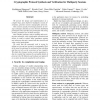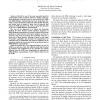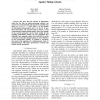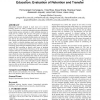CSFW
2010
IEEE
14 years 3 months ago
2010
IEEE
—We establish formal bounds for the number of min-entropy bits that can be extracted in a timing attack against a cryptosystem that is protected by blinding, the state-of-the art...
CSFW
2010
IEEE
14 years 3 months ago
2010
IEEE
—Zero-knowledge proofs have a vast applicability in the domain of cryptography, stemming from the fact that they can be used to force potentially malicious parties to abide by th...
CSFW
2009
IEEE
14 years 3 months ago
2009
IEEE
We present the design and implementation of a compiler that, given high-level multiparty session descriptions, generates custom cryptographic protocols. Our sessions specify pre-a...
CSFW
2009
IEEE
14 years 3 months ago
2009
IEEE
This paper presents a language, based on transaction logic, for specifying dynamic authorisation policies, i.e., rules governing actions that may depend on and update the authoris...
CSFW
2009
IEEE
14 years 3 months ago
2009
IEEE
Specification documents for real-world authentication protocols typically mandate some aspects of a protocol's behavior but leave other features optional or undefined. In add...
CSFW
2009
IEEE
14 years 3 months ago
2009
IEEE
ProVerif is one of the most successful tools for cryptographic protocol analysis. However, dealing with algebraic properties of operators such as the exclusive OR (XOR) and Diffie-...
CSFW
2009
IEEE
14 years 3 months ago
2009
IEEE
ECRIME
2007
14 years 3 months ago
2007
Tools that aim to combat phishing attacks must take into account how and why people fall for them in order to be effective. This study reports a pilot survey of 232 computer users...
ECRIME
2007
14 years 3 months ago
2007
Educational materials designed to teach users not to fall for phishing attacks are widely available but are often ignored by users. In this paper, we extend an embedded training m...
ECRIME
2007
14 years 3 months ago
2007
There are many applications available for phishing detection. However, unlike predicting spam, there are only few studies that compare machine learning techniques in predicting ph...




